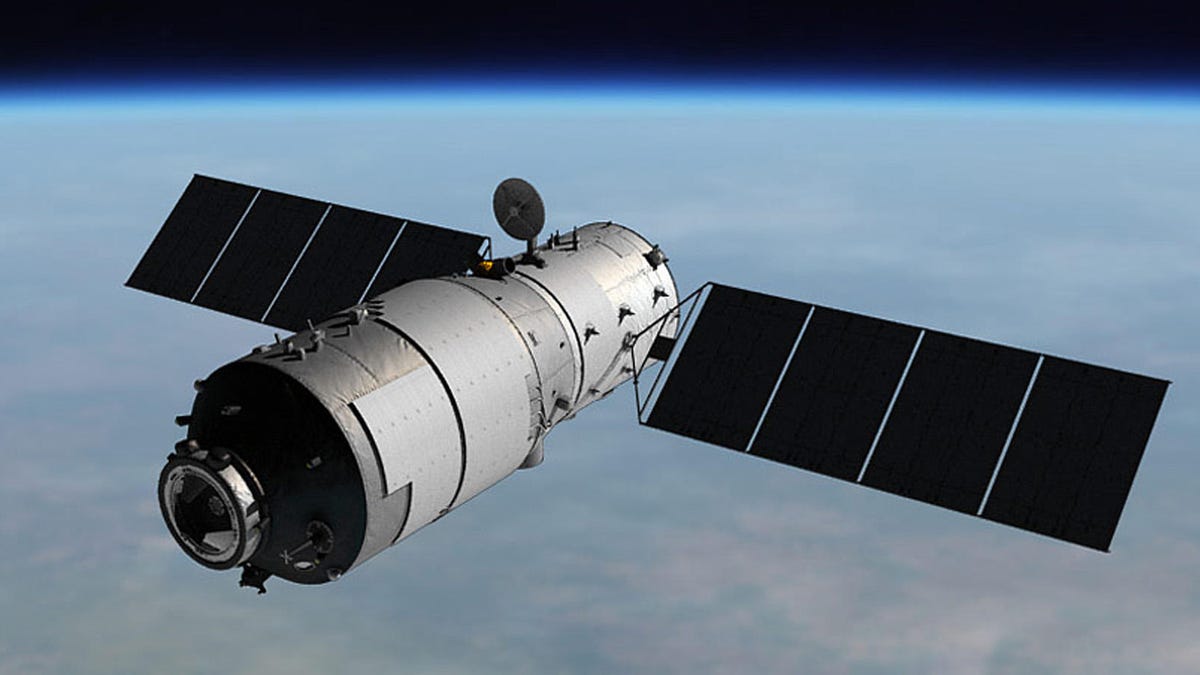Why China's Tiangong-1 space station could crash almost anywhere
Tiangong-1 is likely out of control and headed for a collision with our atmosphere, and perhaps with Earth itself. Figuring out where it'll land is a nearly impossible task.

An artist's rendition of Tiangong-1 in orbit.
China's first space station, Tiangong-1, is believed to be in the midst of an uncontrolled slow-motion fall back to Earth that'll end in a blaze of glory, likely in early April. And that's about all we have to go on, because attempting to predict exactly where and when this is all going down is exceedingly difficult.
What we do know is that the oversized hunk of space junk, also known as "Heavenly Palace," will streak across the sky as it collides with the atmosphere and burns up, a sight that may or may not be followed by several crashes or splashes somewhere across a very wide swath of middle latitudes stretching from the northern US to southern Australia.
"At most, we would be able to narrow the reentry location to two or three orbit revolutions. That means that reentry would occur somewhere along a path that extends two to three times around the planet -- a very long path indeed," Bill Ailor, principal engineer for the Center for Orbital and Reentry Debris Studies (CORDS), said in an email.
The problem is that predictions of possible reentry times are based on radar observations that Ailor says are typically not made frequently enough to formulate solid predictions.
"We'll know it's reentered either when someone sees the bright and spectacular breakup event or it no longer appears to observers (radar or otherwise) when expected."
Once those visible streaks in the sky are seen, it'll let us know what region of the globe may be hit with the few, if any, surviving hunks of debris that make it all the way to the surface. But it will still be basically impossible to pinpoint a possible impact zone.
"Typically, the portion with the visible 'streaks' in the sky will last from several seconds to perhaps a minute. But this occurs at a very high altitude, and the pieces will then take several more minutes to fall to Earth," said Ted Muelhaupt, associate principal director of CORDS' systems analysis and simulation subdivision.
In 2013, a meteor collided with the atmosphere over Chelyabinsk, Russia, and sent out a shock wave that blew out windows on the ground below. However, the small chunk that made it to the surface wound up at the bottom of a frozen lake 43 miles (70 km) away.
How one Russian driver saw the new arrival at Chelyabinsk.
"Keep in mind that objects in orbit, even a decaying orbit, are moving very fast," Muelhaupt said. "Even a one-minute error in the prediction or the reentry time will move the location of the event 280 miles (448 km). The reentry event itself takes several minutes."
In other words, it's incredibly difficult to predict anything about the last moments of Tiangong-1 with much specificity. We do know, though, that it's very, very unlikely its debris will damage anyone or anything on Earth. There's only been one reported case of someone being hit by space junk, and no injuries were reported from that incident.
"Most reentries pass without notice. If a reentry occurs over a populated area with clear skies and darkness, the reentry might be observed," Muelhaupt said.
We'll nevertheless be keeping an eye on the sky as April and Tiangong-1 approach.
Crowd Control: A crowdsourced science fiction novel written by CNET readers.
Solving for XX: The tech industry seeks to overcome outdated ideas about "women in tech."

